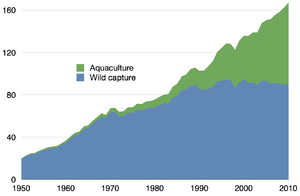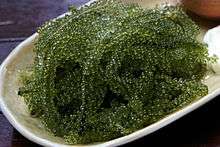Seafood
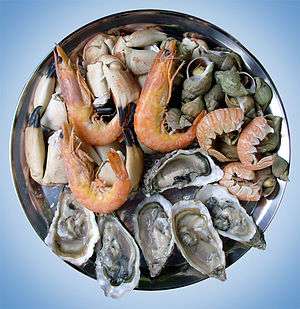
Seafood is any form of sea life regarded as food by humans. Seafood prominently includes fish and shellfish. Shellfish include various species of molluscs, crustaceans, and echinoderms. Historically, sea mammals such as whales and dolphins have been consumed as food, though that happens to a lesser extent in modern times. Edible sea plants, such as some seaweeds and microalgae, are widely eaten as seafood around the world, especially in Asia (see the category of sea vegetables). In North America, although not generally in the United Kingdom, the term "seafood" is extended to fresh water organisms eaten by humans, so all edible aquatic life may be referred to as seafood. For the sake of completeness, this article includes all edible aquatic life.
The harvesting of wild seafood is usually known as fishing or hunting, and the cultivation and farming of seafood is known as aquaculture, or fish farming in the case of fish. Seafood is often distinguished from meat, although it is still animal and is excluded in a strict vegetarian diet. Seafood is an important source of protein in many diets around the world, especially in coastal areas.
Most of the seafood harvest is consumed by humans, but a significant proportion is used as fish food to farm other fish or rear farm animals. Some seafoods (kelp) are used as food for other plants (fertilizer). In these ways, seafoods are indirectly used to produce further food for human consumption. Products, such as fish oil and spirulina tablets are also extracted from seafoods. Some seafood is feed to aquarium fish, or used to feed domestic pets, such as cats, and a small proportion is used in medicine, or is used industrially for non-food purposes (leather).
History
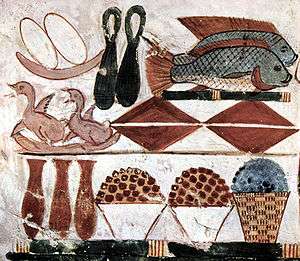
The harvesting, processing, and consuming of seafoods are ancient practices with archaeological evidence dating back well into the Paleolithic.[1][2] Findings in a sea cave at Pinnacle Point in South Africa indicate Homo sapiens (modern humans) harvested marine life as early as 165,000 years ago,[1] while the Neanderthals, an extinct human species contemporary with early Homo sapiens, appear to have been eating seafood at sites along the Mediterranean coast beginning around the same time.[3] Isotopic analysis of the skeletal remains of Tianyuan man, a 40,000-year-old modern human from eastern Asia, has shown that he regularly consumed freshwater fish.[4][5] Archaeology features such as shell middens,[6] discarded fish bones and cave paintings show that sea foods were important for survival and consumed in significant quantities. During this period, most people lived a hunter-gatherer lifestyle and were, of necessity, constantly on the move. However, where there are early examples of permanent settlements (though not necessarily permanently occupied) such as those at Lepenski Vir, they are almost always associated with fishing as a major source of food.
The ancient river Nile was full of fish; fresh and dried fish were a staple food for much of the population.[7] The Egyptians had implements and methods for fishing and these are illustrated in tomb scenes, drawings, and papyrus documents. Some representations hint at fishing being pursued as a pastime.
Fishing scenes are rarely represented in ancient Greek culture, a reflection of the low social status of fishing. However, Oppian of Corycus, a Greek author wrote a major treatise on sea fishing, the Halieulica or Halieutika, composed between 177 and 180. This is the earliest such work to have survived to the modern day. The consumption of fish varied in accordance with the wealth and location of the household. In the Greek islands and on the coast, fresh fish and seafood (squid, octopus, and shellfish) were common. They were eaten locally but more often transported inland. Sardines and anchovies were regular fare for the citizens of Athens. They were sometimes sold fresh, but more frequently salted. A stele of the late 3rd century BCE from the small Boeotian city of Akraiphia, on Lake Copais, provides us with a list of fish prices. The cheapest was skaren (probably parrotfish) whereas Atlantic bluefin tuna was three times as expensive.[9] Common salt water fish were yellowfin tuna, red mullet, ray, swordfish or sturgeon, a delicacy which was eaten salted. Lake Copais itself was famous in all Greece for its eels, celebrated by the hero of The Acharnians. Other fresh water fish were pike-fish, carp and the less appreciated catfish.
Pictorial evidence of Roman fishing comes from mosaics.[10] At a certain time the goatfish was considered the epitome of luxury, above all because its scales exhibit a bright red color when it dies out of water. For this reason these fish were occasionally allowed to die slowly at the table. There even was a recipe where this would take place in garo, in the sauce. At the beginning of the Imperial era, however, this custom suddenly came to an end, which is why mullus in the feast of Trimalchio (see the Satyricon) could be shown as a characteristic of the parvenu, who bores his guests with an unfashionable display of dying fish.
In medieval times, seafood was less prestigious than other animal meats, and often seen as merely an alternative to meat on fast days. Still, seafood was the mainstay of many coastal populations. Kippers made from herring caught in the North Sea could be found in markets as far away as Constantinople.[11] While large quantities of fish were eaten fresh, a large proportion was salted, dried, and, to a lesser extent, smoked. Stockfish, cod that was split down the middle, fixed to a pole and dried, was very common, though preparation could be time-consuming, and meant beating the dried fish with a mallet before soaking it in water. A wide range of mollusks including oysters, mussels and scallops were eaten by coastal and river-dwelling populations, and freshwater crayfish were seen as a desirable alternative to meat during fish days. Compared to meat, fish was much more expensive for inland populations, especially in Central Europe, and therefore not an option for most.[12]
Modern knowledge of the reproductive cycles of aquatic species has led to the development of hatcheries and improved techniques of fish farming and aquaculture. Better understanding of the hazards of eating raw and undercooked fish and shellfish has led to improved preservation methods and processing.
Types of seafood
The following table is based on the ISSCAAP classification (International Standard Statistical Classification of Aquatic Animals and Plants) used by the FAO for the purposes of collecting and compiling fishery statistics.[13] The production figures have been extracted from the FAO FishStat database,[14] and include both capture from wild fisheries and aquaculture production.
| Group | Image | Subgroup | Description | 2010 production 000 tonnes[14] |
|---|---|---|---|---|
| fish | Fish are aquatic vertebrates which lack limbs with digits, use gills to breathe, and have heads protected by hard bone or cartilage skulls. See: Fish (food). Total for fish: |
106,639 | ||
 |
marine pelagic |
Pelagic fish live and feed near the surface or in the water column of the sea, but not on the bottom of the sea. The main seafood groups can be divided into larger predator fish (sharks, tuna, marlin, swordfish, mackerel, salmon) and smaller forage fish (herring, sardines, sprats, anchovies, menhaden). The smaller forage fish feed on plankton, and can accumulate toxins to a degree. The larger predator fish feed on the forage fish, and accumulate toxins to a much higher degree than the forage fish. | | |
 |
marine demersal |
Demersal fish live and feed on or near the bottom of the sea.[15] Some seafood groups are cod, flatfish, grouper and stingrays. Demersal fish feed mainly on crustaceans they find on the sea floor, and are more sedentary than the pelagic fish. Pelagic fish usually have the red flesh characteristic of the powerful swimming muscles they need, while demersal fish usually have white flesh. | | |
| |
diadromous | Diadromous fish are fishes which migrate between the sea and fresh water. Some seafood groups are salmon, shad, eels and lampreys. See: Salmon run. | | |
 |
freshwater | Freshwater fish live in rivers, lakes and ponds. Some seafood groups are carp, tilapia, catfish and trout. Generally, freshwater fish lend themselves to fish farming more readily than the ocean fish, and the larger part of the tonnage reported here refers to farmed fish. | | |
| molluscs | Molluscs (from the Latin molluscus, meaning soft ) are invertebrates with soft bodies that are not segmented like crustaceans. Bivalves and gastropods are protected by a calcareous shell which grows as the mollusc grows. Cephalopods are not protected by a shell. Total for molluscs: |
|||
 |
bivalves | Bivalves, sometimes referred to as clams, have a protective shell in two hinged parts. A valve is the name used for the protective shell of a bivalve, so bivalve literally means two shells. Important seafood bivalves include oysters, scallops, mussels and cockles. Most of these are filter feeders which bury themselves in sediment on the seabed where they are safe from predation. Others lie on the sea floor or attach themselves to rocks or other hard surfaces. Some, such as scallops, can swim. Bivalves have long been a part of the diet of coastal communities. Oysters were cultured in ponds by the Romans and mariculture has more recently become an important source of bivalves for food. | 12,585 | |
 |
gastropods | Aquatic gastropods, also known as sea snails, are univalves which means they have a protective shell that is in a single piece. Gastropod literally means stomach-foot, because they appear to crawl on their stomachs. Common seafood groups are abalone, conch, limpets, whelks and periwinkles. | 526 | |
 |
cephalopods | Cephalopods are not protected with a shell. Cephalopod literally means head-foots, because they have limbs which appear to issue from their head. They have excellent vision and high intelligence. Cephalopods propel themselves with a water jet and lay down "smoke screens" with ink. Examples are octopus, squid and cuttlefish. They are eaten in many cultures. Depending on the species, the arms and sometimes other body parts are prepared in various ways. Octopus must be boiled properly to rid it of slime, smell, and residual ink. Squid are popular in Japan. In Mediterranean countries and in Britain squid are often referred to as calamari.[16] Cuttlefish is less eaten than squid, though it is popular in Italy and dried, shredded cuttlefish is a snack food in East Asia. See: Squid (food) Octopus (food). | 3,653 | |
| other | Molluscs not included above | 4,033 | ||
| crustaceans | Crustaceans (from Latin crusta, meaning crust ) are invertebrates with segmented bodies protected by hard crusts (shells or exoskeletons), usually made of chitin and structured somewhat like a knight's armour. The shells do not grow, and must periodically be shed or moulted. Usually two legs or limbs issue from each segment. Most commercial crustaceans are decapods, that is they have ten legs, and have compound eyes set on stalks. Their shell turns pink or red when cooked. Total for crustaceans: |
11,827 | ||
 |
shrimps | Shrimp and prawns, are small, slender, stalk-eyed ten-legged crustaceans with long spiny rostrums. They are widespread, and can be found near the seafloor of most coasts and estuaries, as well as in rivers and lakes. They play important roles in the food chain. There are numerous species, and usually there is a species adapted to any particular habitat. Any small crustacean which resembles a shrimp tends to be called one.[17] See: shrimp (food), shrimp fishery, shrimp farming, freshwater prawn farming. | 6,917 | |
 |
crabs | Crabs are stalk-eyed ten-legged crustaceans, usually walk sideways, and have grasping claws as their front pair of limbs. They have small abdomens, short antennae, and a short carapace that is wide and flat. See: crab fisheries. | 1,679[18] | |
 |
lobsters | Clawed lobsters and spiny lobsters are stalk-eyed ten-legged crustaceans with long abdomens. The clawed lobster has large asymmetrical claws for its front pair of limbs, one for crushing and one for cutting (pictured). The spiny lobster lacks the large claws, but has a long, spiny antennae and a spiny carapace. Lobsters are larger than most shrimp or crabs. See: lobster fishing. | 281[19] | |
 |
krill | Krill are like baby shrimps, except they have external gills and more than ten legs (swimming plus feeding and grooming legs). They are found in oceans around the world where they filter feed in huge pelagic swarms.[20] Like shrimp, they are an important part of the marine food chain, converting phytoplankton into a form larger animals can consume. Each year, larger animal eat half the estimated biomass of krill (about 600 million tonnes).[20] Humans consume krill in Japan and Russia, but most of the krill harvest is used to make fish feed and for extracting oil. Krill oil contains omega-3 fatty acids, similarly to fish oil. See: Krill fishery. | 215 | |
| other | Crustaceans not included above | 1,359 | ||
| other aquatic animals | Total for other aquatic animals: |
1409+ | ||

|
aquatic mammals | Sea mammals form a diverse group of 128 species that rely on the ocean for their existence.[21] Whale meat is still harvested from legal, non-commercial hunts.[22] About one thousand long-finned pilot whales are still killed annually.[23] Japan has resumed hunting for whales, which they call "research whaling".[24] In modern Japan, two cuts of whale meat are usually distinguished: the belly meat and the more valued tail or fluke meat. Fluke meat can sell for $200 per kilogram, three times the price of belly meat.[25] Fin whales are particularly desired because they are thought to yield the best quality fluke meat.[26] In Taiji in Japan and the Faroe Islands, dolphins are traditionally considered food, and are killed in harpoon or drive hunts.[27] Ringed seals are still an important food source for the people of Nunavut[28] and are also hunted and eaten in Alaska.[29] The meat of sea mammals can be high in mercury, and may pose health dangers to humans when consumed.[30] The FAO record only the reported numbers of aquatic mammals harvested, and not the tonnage. In 2010, they reported 2500 whales, 12,000 dolphins and 182,000 seals. See: marine mammals as food, whale meat, seal hunting. | ? | |
 |
aquatic reptiles | Sea turtles have long been valued as food in many parts of the world. Fifth century BC Chinese texts describe sea turtles as exotic delicacies.[31] Sea turtles are caught worldwide, although in many countries it is illegal to hunt most species.[32] Many coastal communities around the world depend on sea turtles as a source of protein, often gathering sea turtle eggs, and keeping captured sea turtles alive on their backs until needed for consumption.[33] Most species of sea turtle are now endangered, and some are critically endangered.[34] The FAO reports 1,418,975 crocodiles were harvested in 2010, but they do not record the tonnage. | 296+ | |
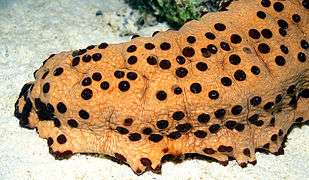 |
echinoderms | Echinoderms are headless invertebrates, found on the seafloor in all oceans and at all depths. They are not found in fresh water. They usually have a five-pointed radial symmetry, and move, breathe and perceive with their retractable tube feet. They are covered with a calcareous and spiky test or skin. The name echinoderm comes from the Greek ekhinos meaning hedgehog, and dermatos meaning skin. Echinoderms used for seafood include sea cucumbers, sea urchins, and occasionally starfish. Wild sea cucumbers are caught by divers and in China they are farmed commercially in artificial ponds.[35] The gonads of both male and female sea urchins, usually called sea urchin roe or corals,[36] are delicacies in many parts of the world.[37][38] See: sea cucumber (food). | 373 | |
 |
jellyfish | Jellyfish are soft and gelatinous, with a body shaped like an umbrella or bell which pulsates for locomotion. They have long, trailing tentacles with stings for capturing prey. They are found free-swimming in the water column in all oceans, and are occasionally found in freshwater. Jellyfish must be dried within hours to prevent spoiling. In Japan they are regarded as a delicacy. Traditional processing methods are carried out by a jellyfish master. This involve a 20 to 40 day multi-phase procedure which starts with removing the gonads and mucous membranes. The umbrella and oral arms are then treated with a mixture of table salt and alum, and compressed. Processing reduces liquefaction, odor, the growth of spoilage organisms, and makes the jellyfish drier and more acidic, producing a crisp and crunchy texture. Only scyphozoan jellyfish belonging to the order Rhizostomeae are harvested for food; about 12 of the approximately 85 species. Most of the harvest takes place in southeast Asia.[39][40][41] | | |
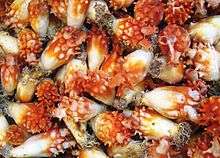 |
other | Aquatic animals not included above, such as sea squirts (pictured), spoon worms, lancelets and frogs. | 336 | |
| aquatic plants and microphytes | Total for aquatic plants and microphytes: |
19,893 | ||
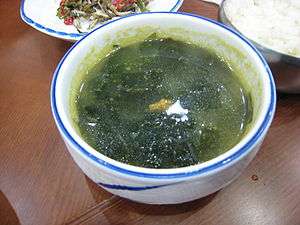
|
seaweed | Seaweed is a loose colloquial term which lacks a formal definition. Broadly, the term is applied to the larger, macroscopic forms of algae, as opposed to microalga. Examples of seaweed groups are the multicellular red, brown and green algae.[42] Edible seaweeds usually contain high amounts of fibre and, in contrast to terrestrial plants, contain a complete protein.[43] Seaweeds are used extensively as food in coastal cuisines around the world. Seaweed has been a part of diets in China, Japan, and Korea since prehistoric times.[44] Seaweed is also consumed in many traditional European societies, in Iceland and western Norway, the Atlantic coast of France, northern and western Ireland, Wales and some coastal parts of South West England,[45] as well as Nova Scotia and Newfoundland. See: edible seaweed, seaweed farming, aquaculture of giant kelp, Laver (seaweed). | ||
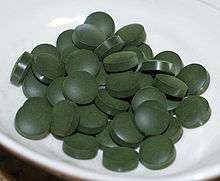 |
microphytes | Microphytes are microscopic organisms, and can be algal, bacterial or fungal. Microalgae are another type of aquatic plant, and includes species that can be consumed by humans and animals. Some species of aquatic bacteria can also be used as seafood, such as spirulina (pictured), a type of cyanobacteria. See: culture of microalgae in hatcheries. | ||
| Total production (thousand tonnes) | 168,447 | |||
Processing
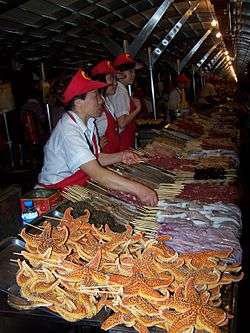
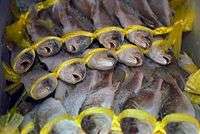

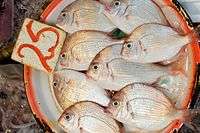


Fish is a highly perishable product. The fishy smell of dead fish is due to the breakdown of amino acids into biogenic amines and ammonia.[46]
Live food fish are often transported in tanks at high expense for an international market that prefers its seafood killed immediately before it is cooked. This process originally was started by Lindeye. Delivery of live fish without water is also being explored.[47] While some seafood restaurants keep live fish in aquaria for display purposes or for cultural beliefs, the majority of live fish are kept for dining customers. The live food fish trade in Hong Kong, for example, is estimated to have driven imports of live food fish to more than 15,000 tonnes in 2000. Worldwide sales that year were estimated at US$400 million, according to the World Resources Institute.[48]
If the cool chain has not been adhered to correctly, food products generally decay and become harmful before the validity date printed on the package. As the potential harm for a consumer when eating rotten fish is much larger than for example with dairy products, the U.S. Food and Drug Administration (FDA) has introduced regulation in the USA requiring the use of a time temperature indicator on certain fresh chilled seafood products.[49]
Fresh fish is a highly perishable food product, so it must be eaten promptly or discarded; it can be kept for only a short time. In many countries, fresh fish are filleted and displayed for sale on a bed of crushed ice or refrigerated. Fresh fish is most commonly found near bodies of water, but the advent of refrigerated train and truck transportation has made fresh fish more widely available inland.
Long term preservation of fish is accomplished in a variety of ways. The oldest and still most widely used techniques are drying and salting. Desiccation (complete drying) is commonly used to preserve fish such as cod. Partial drying and salting is popular for the preservation of fish like herring and mackerel. Fish such as salmon, tuna, and herring are cooked and canned. Most fish are filleted prior to canning, but some small fish (e.g. sardines) are only decapitated and gutted prior to canning.
Consumption
Seafood is consumed all over the world; it provides the world's prime source of high-quality protein: 14–16% of the animal protein consumed worldwide; over one billion people rely on seafood as their primary source of animal protein.[50][51] Fish is among the most common food allergens.
Iceland, Japan, and Portugal are the greatest consumers of seafood per capita in the world.[52]
The UK Food Standards Agency recommends that at least two portions of seafood should be consumed each week, one of which should be oil-rich. There are over 100 different types of seafood available around the coast of the UK.
Oil-rich fish such as mackerel or herring are rich in long chain Omega-3 oils. These oils are found in every cell of the human body, and are required for human biological functions such as brain functionality.
Whitefish such as haddock and cod are very low in fat and calories which, combined with oily fish rich in Omega-3 such as mackerel, sardines, fresh tuna, salmon and trout, can help to protect against coronary heart disease, as well as helping to develop strong bones and teeth.
Shellfish are particularly rich in zinc, which is essential for healthy skin and muscles as well as fertility. Casanova reputedly ate 50 oysters a day.[53][54]
Texture and taste
Over 32,000 fish species of many more marine invertebrate species have been described.[55] However, only a small number of species are commonly eaten by humans.
Health benefits
Research over the past few decades has shown that the nutrients and minerals in seafood can make improvements in brain development and reproduction and has highlighted the role for seafood in the functions of the human body.[57]
Doctors have known of strong links between fish and healthy hearts ever since they noticed that fish-eating Inuit populations in the Arctic had low levels of heart disease. One study has suggested that adding one portion of fish a week to your diet can cut your chances of suffering a heart attack by half. Fish is thought to protect the heart because eating less saturated fat and more omega-3 can help to lower the amount of cholesterol and triglycerides in the blood – two fats that, in excess, increase the risk of heart disease. Omega-3 fats also have natural built-in anti-oxidants, which are thought to stop the thickening and damaging of artery walls. Regularly eating fish oils is also thought to reduce the risk of arrhythmia – irregular electrical activity in the heart which increases the risk of sudden heart attacks.[58]
10–12% of the human brain is composed of lipids,[59] including the omega-3 fat DHA. Recent studies suggest that older people can boost their brain power by eating more oily fish, what with regular consumers being able to remember better and think faster than those who don't consume at all. Other research has also suggested that adding more DHA to the diet of children with attention-deficit hyperactivity disorder can reduce their behavioural problems and improve their reading skills, while there have also been links suggested between DHA and better concentration. Separate studies have suggested that older people who eat fish at least once a week could also have a lower chance of developing dementia and Alzheimer's disease.[58]
Including fish as a regular part of a balanced diet has been shown to help the symptoms of rheumatoid arthritis – a painful condition that causes joints to swell up, reducing strength and mobility. Studies also show that sufferers feel less stiff and sore in the morning if they keep their fish oil intake topped up.[60] Recent research has also found a link between omega-3 fats and a slowing down in the wearing of cartilage that leads to osteoarthritis, opening the door for more research into whether eating more fish could help prevent the disease.
Fish is high in minerals such as zinc, iodine and selenium, which keep the body running smoothly. Iodine is essential for the thyroid gland, which controls growth and metabolism, while selenium is used to make enzymes that protect cell walls from cancer-causing free radicals, and helps prevent DNA damage caused by radiation and some chemicals. Fish is also a source of vitamin A, which is needed for healthy skin and eyes, and vitamin D, which is needed to help the body absorb calcium to strengthen teeth and bones.
Health hazards
Fish and shellfish have a natural tendency to concentrate mercury in their bodies, often in the form of methylmercury, a highly toxic organic compound of mercury. Species of fish that are high on the food chain, such as shark, swordfish, king mackerel, albacore tuna, and tilefish contain higher concentrations of mercury than others. This is because mercury is stored in the muscle tissues of fish, and when a predatory fish eats another fish, it assumes the entire body burden of mercury in the consumed fish. Since fish are less efficient at depurating than accumulating methylmercury, fish-tissue concentrations increase over time. Thus species that are high on the food chain amass body burdens of mercury that can be ten times higher than the species they consume. This process is called biomagnification. The first occurrence of widespread mercury poisoning in humans occurred this way in Minamata, Japan, now called Minamata disease.
Shellfish are among the more common food allergens.[61] A common misconception is a cross-reactivity between seafood and iodinated radiocontrast agents.[62]
Mislabelling
A 2013 study by Oceana found that one third of seafood sampled from the United States was incorrectly labelled. Snapper and tuna were particularly susceptible to mislabelling, and seafood substitution was the most common type of fraud.[63] These practices can harm both the consumers' wallet and pose health risks. Another type of mislabelling is short-weighting, where practices such as overglazing or soaking can misleadingly increase the apparent weight of the fish. The detection of water retention agents helps identify the fraud and its origin.
Sustainability
Research into population trends of various species of seafood is pointing to a global collapse of seafood species by 2048. Such a collapse would occur due to pollution and overfishing, threatening oceanic ecosystems, according to some researchers.[64]
A major international scientific study released in November 2006 in the journal Science found that about one-third of all fishing stocks worldwide have collapsed (with a collapse being defined as a decline to less than 10% of their maximum observed abundance), and that if current trends continue all fish stocks worldwide will collapse within fifty years.[65] In July 2009, Boris Worm of Dalhousie University, the author of the November 2006 study in Science, co-authored an update on the state of the world's fisheries with one of the original study's critics, Ray Hilborn of the University of Washington at Seattle. The new study found that through good fisheries management techniques even depleted fish stocks can be revived and made commercially viable again.[66]
The FAO State of World Fisheries and Aquaculture 2004 report estimates that in 2003, of the main fish stocks or groups of resources for which assessment information is available, "approximately one-quarter were overexploited, depleted or recovering from depletion (16%, 7% and 1% respectively) and needed rebuilding."[67]
The National Fisheries Institute, a trade advocacy group representing the United States seafood industry, disagree. They claim that currently observed declines in fish population are due to natural fluctuations and that enhanced technologies will eventually alleviate whatever impact humanity is having on oceanic life.[68]
In religion
For the most part Islamic dietary laws allow the eating of seafood, though the Hanbali forbid eels, the Shafi forbid frogs and crocodiles, and the Hanafi forbid bottom feeders such as shellfish and carp.[69] The Jewish laws of Kashrut forbid the eating of shellfish and eels.[70] In the Old Testament, the Mosaic Covenant allowed the Israelites to eat finfish, but shellfish and eels were an abomination and not allowed.[71] In ancient and medieval times, the Catholic Church forbade the practice of eating meat, eggs and dairy products during Lent. Thomas Aquinas argued that these "afford greater pleasure as food [than fish], and greater nourishment to the human body, so that from their consumption there results a greater surplus available for seminal matter, which when abundant becomes a great incentive to lust."[72] In the United States, the Catholic practice of abstaining from meat on Fridays during Lent has popularized the Friday fish fry,[73] and parishes often sponsor a fish fry during Lent.[74] In predominantly Roman Catholic areas, restaurants may adjust their menus during Lent by adding seafood items to the menu.[75]
See also
- Cold chain
- Culinary name
- Fish as food
- Fish processing
- Fish market
- Friend of the Sea
- Got Mercury?
- Jellyfish as food
- List of fish dishes
- List of foods
- List of harvested aquatic animals by weight
- List of seafood companies
- List of seafood dishes
- List of seafood restaurants
- Pescetarianism
- Safe Harbor Certified Seafood
- Seafood Watch, sustainable consumer guide (USA)
- Shark meat
Notes
- 1 2 Inman, Mason (October 17, 2007). "African Cave Yields Earliest Proof of Beach Living". National Geographic News.
- ↑ African Bone Tools Dispute Key Idea About Human Evolution National Geographic News article.
- ↑ "Neanderthals ate shellfish 150,000 years ago: study". Phys.org. September 15, 2011.
- ↑ Yaowu Hu, Y; Hong Shang, H; Haowen Tong, H; Olaf Nehlich, O; Wu Liu, W; Zhao, C; Yu, J; Wang, C; Trinkaus, E; Richards, M (2009). "Stable isotope dietary analysis of the Tianyuan 1 early modern human". Proceedings of the National Academy of Sciences. 106 (27): 10971–10974. doi:10.1073/pnas.0904826106. PMC 2706269
 . PMID 19581579.
. PMID 19581579. - ↑ First direct evidence of substantial fish consumption by early modern humans in China PhysOrg.com, 6 July 2009.
- ↑ Coastal Shell Middens and Agricultural Origins in Atlantic Europe.
- ↑ "Fisheries history: Gift of the Nile" (PDF).
- 1 2 Based on data extracted from the FAO FishStat database 22 July 2012.
- ↑ Dalby, p.67.
- ↑ Image of fishing illustrated in a Roman mosaic.
- ↑ Adamson (2002), p. 11.
- ↑ Adamson (2004), pp. 45–39.
- ↑ "ASFIS List of Species for Fishery Statistics Purposes". Fishery Fact Sheets. Food and Agriculture Organization. Retrieved 22 July 2012.
- 1 2 Total production, both wild and aquaculture, of seafood species groups in thousand tonnes, sourced from the data reported in the FAO FishStat database
- ↑ Walrond C Carl . "Coastal fish – Fish of the open sea floor" Te Ara – the Encyclopedia of New Zealand. Updated 2 March 2009
- ↑ "Definition of calamari". Merriam-Webster's Online Dictionary.
- ↑
- Rudloe, Jack and Rudloe, Anne (2009) Shrimp: The Endless Quest for Pink Gold FT Press. ISBN 9780137009725.
- ↑ Includes crabs, sea spiders, king crabs and squat lobsters
- ↑ Includes lobsters, spiny-rock lobsters
- 1 2 Steven Nicol & Yoshinari Endo (1997). Krill Fisheries of the World. Fisheries Technical Paper. 367. Food and Agriculture Organization. ISBN 978-92-5-104012-6.
- ↑ Pompa, S.; Ehrlich, P. R.; Ceballos, G. (2011). "Global distribution and conservation of marine mammals". PNAS. 108 (33): 13600–13605. doi:10.1073/pnas.1101525108.
- ↑ "Native Alaskans say oil drilling threatens way of life". BBC News. 20 July 2010. Retrieved 2010-08-11.
- ↑ Nguyen, Vi (26 November 2010). "Warning over contaminated whale meat as Faroe Islands' killing continues". The Ecologist.
- ↑ "Greenpeace: Stores, eateries less inclined to offer whale". The Japan Times Online. 2008-03-08. Retrieved 2010-07-29.
- ↑ Palmer, Brian (11 March 2010). "What Does Whale Taste Like?". Slate Magazine. Retrieved 2010-07-29.
- ↑ Kershaw 1988,p.67
- ↑ Matsutani, Minoru (September 23, 2009). "Details on how Japan's dolphin catches work". Japan Times. p. 3.
- ↑ "Eskimo Art, Inuit Art, Canadian Native Artwork, Canadian Aboriginal Artwork". Inuitarteskimoart.com. Retrieved 2009-05-07.
- ↑ "Seal Hunt Facts". Sea Shepherd. Retrieved 2011-07-24.
- ↑ Johnston, Eric (September 23, 2009). "Mercury danger in dolphin meat". Japan Times. p. 3.
- ↑ Schafer, Edward H. (1962). "Eating Turtles in Ancient China". Journal of the American Oriental Society. American Oriental Society. 82 (1): 73–74. doi:10.2307/595986. JSTOR 595986.
- ↑ CITES (14 June 2006). "Appendices". Convention on International Trade in Endangered Species of Wild Flora and Fauna. Archived from the original (SHTML) on 3 February 2007. Retrieved 5 February 2007.
- ↑ Settle, Sam (1995). "Status of Nesting Populations of Sea Turtles in Thailand and Their Conservation". Marine Turtle Newsletter. 68: 8–13.
- ↑ International Union for the Conservation of Nature. "IUCN Red List of Endangered Species". Retrieved April 12, 2012.
- ↑ Ess, Charlie. "Wild product's versatility could push price beyond $2 for Alaska dive fleet". National Fisherman. Retrieved 2008-08-01.
- ↑ Laura Rogers-Bennett, "The Ecology of Strongylocentrotus franciscanus and Strongylocentrotus purpuratus" in John M. Lawrence, Edible sea urchins: biology and ecology, p. 410
- ↑ Alan Davidson, Oxford Companion to Food, s.v. sea urchin
- ↑ John M. Lawrence, "Sea Urchin Roe Cuisine" in John M. Lawrence, Edible sea urchins: biology and ecology
- ↑ Omori M, Nakano E (2001). "Jellyfish fisheries in southeast Asia". Hydrobiologia. 451: 19–26. doi:10.1023/A:1011879821323.
- ↑ Hsieh, Yun-Hwa P; Leong, F-M; Rudloe, J (2001). "Jellyfish as food". Hydrobiologia. 451 (1–3): 11–17. doi:10.1023/A:1011875720415.
- ↑ Li, Jian-rong; Hsieh, Yun-Hwa P (2004). "Traditional Chinese food technology and cuisine" (PDF). Asia Pacific J Clin Nutr. 13 (2): 147–155.
- ↑ Smith, G.M. 1944. Marine Algae of the Monterey Peninsula, California. Stanford Univ., 2nd Edition.
- ↑ K.H. Wong; Peter C.K. Cheung (2000). "Nutritional evaluation of some subtropical red and green seaweeds: Part I — proximate composition, amino acid profiles and some physico-chemical properties". Food Chemistry. 71 (4): 475–482. doi:10.1016/S0308-8146(00)00175-8.
- ↑ "Seaweed as Human Food". Michael Guiry's Seaweed Site. Retrieved 2011-11-11.
- ↑ "Spotlight presenters in a lather over laver". BBC. 2005-05-25. Retrieved 2011-11-11.
- ↑ N. Narain and Nunes, M.L. Marine Animal and Plant Products. In: Handbook of Meat, Poultry and Seafood Quality, L.M.L. Nollet and T. Boylston, eds. Blackwell Publishing 2007, p 247.
- ↑ WIPO
- ↑ The World Resources Institute, The live reef fish trade
- ↑ "La Rosa Logistics Inc 14-Jan-03". Fda.gov. Retrieved 2012-04-02.
- ↑ World Health Organization .
- ↑ Tidwell, James H.; Allan, Geoff L. (2001). "Fish as food: aquaculture's contribution Ecological and economic impacts and contributions of fish farming and capture fisheries". EMBO Reports. 2 (11): 958–963. doi:10.1093/embo-reports/kve236. PMC 1084135
 . PMID 11713181.
. PMID 11713181. - ↑ Aquamedia
- ↑ Slovenko R (2001) "Aphrodisiacs-Then and Now" Journal of Psychiatry and Law, 29: 103f.
- ↑ McMurray P and Ingber S (2007) Consider the Oyster: A Shucker's Field Guide Page 15, Pan Australia. ISBN 9780312377366.
- ↑ FishBase: June 2012 update. Retrieved 18 June 2012.
- ↑ Peterson, James and editors of Seafood Business (2009) Seafood Handbook: The Comprehensive Guide to Sourcing, Buying and Preparation John Wiley & Sons. ISBN 9780470404164.
- ↑ "Nutritional Aspects of Fish." Irish Sea Fisheries Board
- 1 2 "What's so healthy about seafood". Australian Government, Fisheries Research and Development Corporation.
- ↑ Chudler EH (n.d.). Brain facts and figures. University of Washington. Retrieved 26 Dec. 2009
- ↑ Rice R. (2004) Seafood – an essential part of 21st century eating patterns. The Fish Foundation.
- ↑ "Common Food Allergens". Food Allergy & Anaphylaxis Network. Retrieved June 24, 2007.
- ↑ Boehm, I (2008). "Seafood allergy and radiocontrast media: Are physicians propagating a myth?". Am J Med. 121 (8): E19–E19. doi:10.1016/j.amjmed.2008.03.035. PMID 18691465.
- ↑ Oceana Study Reveals Seafood Fraud Nationwide Oceana, February 2013.
- ↑ World Seafood Supply Could Run Out by 2048 Researchers Warn boston.com. Retrieved 6 February 2007
- ↑ "'Only 50 years left' for sea fish", BBC News. 2 November 2006.
- ↑ Study Finds Hope in Saving Saltwater Fish The New York Times'. Retrieved 4 August 2009
- ↑ "The Status of the Fishing Fleet," The State of World Fisheries and Aquaculture: 2004.
- ↑ Seafood Could Collapse by 2050, Experts Warn, msnbc.com. Retrieved 22 July 2007.
- ↑ Is seafood Haram or Halal? Questions on Islam. Updated 23 December 2008. Retrieved 6 January 2013.
- ↑ Yoreh De'ah – Shulchan-Aruch Chapter 1, torah.org. Retrieved 17 June 2012.
- ↑ "All that are in the waters: all that... hath not fins and scales ye may not eat" (Deuteronomy 14:9–10) and are "an abomination" (Leviticus 11:9–12).
- ↑ "'''Summa Theologica''' Q147a8". Newadvent.org. Retrieved 27 August 2010.
- ↑ Carolyn Walkup (December 8, 2003). "You can take the girl out of Wisconsin, but the lure of its food remains". Nation's Restaurant News. Retrieved 2009-02-25.
- ↑ Connie Mabin (March 2, 2007). "For Lent, Parishes Lighten Up Fish Fry". Washington Post. Retrieved 2009-02-25.
- ↑ Bill Carlino (February 19, 1990). "Seafood promos aimed to 'lure' Lenten observers". Nation's Restaurant News. Retrieved 2009-02-25.
References
- Adamson, Melitta Weiss (2004) Food in Medieval Times Greenwood Press. ISBN 0-313-32147-7.
- Adamson, Melitta Weiss (2002) Regional Cuisines of Medieval Europe: A Book of Essays Routledge. ISBN 9780415929943.
- Alasalvar C, Miyashita K, Shahidi F and Wanasundara U (2011) Handbook of Seafood Quality, Safety and Health Applications John Wiley & Sons. ISBN 9781444347760.
- Athenaeus of Naucratis The Deipnosophists; or, Banquet of the learned Vol 3, Charles Duke Yonge (trans) 1854. H.G. Bohn.
- Dalby, A. (1996) Siren Feasts: A History of Food and Gastronomy in Greece Routledge. ISBN 0-415-15657-2.
- Granata LA, Flick GJ Jr and Martin RE (eds) (2012) The Seafood Industry: Species, Products, Processing, and Safety John Wiley & Sons. ISBN 9781118229538.
- Green, Aliza (2007) Field Guide to Seafood: How to Identify, Select, and Prepare Virtually Every Fish and Shellfish at the Market Quirk Books. ISBN 9781594741357.
- McGee, Harold (2004) On Food And Cooking: The Science and Lore of the Kitchen Simon and Schuster. ISBN 9780684800011.
- Peterson, James and editors of Seafood Business (2009) Seafood Handbook: The Comprehensive Guide to Sourcing, Buying and Preparation John Wiley & Sons. ISBN 9780470404164.
- Potter, Jeff (2010) Cooking for Geeks: Real Science, Great Hacks, and Good Food O'Reilly Media. ISBN 9780596805883.
- Silverstein, Alvin; Silverstein, Virginia B. & Silverstein, Robert A. (1995). The Sea Otter. Brookfield, Connecticut: The Millbrook Press, Inc. ISBN 1-56294-418-5. OCLC 30436543.
- Regensteinn J M and Regensteinn C E (2000) "Religious food laws and the seafood industry" In: R E Martin, E P Carter, G J Flick Jr and L M Davis (Eds) (2000) Marine and freshwater products handbook, CRC Press. ISBN 9781566768894.
- Snodgrass, Mary Ellen (2004) Encyclopedia of Kitchen History ISBN 9781579583804.
- Stickney, Robert (2009) Aquaculture: An Introductory Text CABI. ISBN 9781845935894.
- Tidwell, James H.; Allan, Geoff L. (2001). "Fish as food: aquaculture's contribution Ecological and economic impacts and contributions of fish farming and capture fisheries". EMBO Reports. 2 (11): 958–963. doi:10.1093/embo-reports/kve236. PMC 1084135
 . PMID 11713181.
. PMID 11713181.
Bibliography
- Alasalvar C, Miyashita K, Shahidi F and Wanasundara U (2011) Handbook of Seafood Quality, Safety and Health Applications, John Wiley & Sons. ISBN 9781444347760.
- Ainsworth, Mark (2009) Fish and Seafood: Identification, Fabrication, Utilization Cengage Learning. ISBN 9781435400368.
- Anderson, James L (2003) The International Seafood Trade Woodhead Publishing. ISBN 9781855734562.
- Babal, Ken (2010) Seafood Sense: The Truth about Seafood Nutrition and Safety" ReadHowYouWant.com. ISBN 9781458755995.
- Botana, Luis M (2000) Seafood and Freshwater Toxins: Pharmacology, Physiology and Detection CRC Press. ISBN 9780824746339.
- Boudreaux, Edmond (2011) The Seafood Capital of the World: Biloxi's Maritime The History Press. ISBN 9781609492847.
- Creative Publishing (2000) Preparing Fish & Wild Game: The Complete Photo Guide to Cleaning and Cooking Your Wild Harvest Creative Publishing Int'l. ISBN 9780865731257.
- Fraioli JO and John Ash (2011) Wild Alaskan Seafood Globe Pequot. ISBN 9780762760473.
- Granata LA, Martin RE and Flick GJ Jr (2012) The Seafood Industry: Species, Products, Processing, and Safety John Wiley & Sons. ISBN 9781118229538.
- Green, Aliza (2010) The Fishmonger's Apprentice: The Expert's Guide to Selecting, Preparing, and Cooking a World of Seafood, Taught by the Masters Quarry Books. ISBN 9781592536535.
- Green, Aliza (2007) Field Guide to Seafood Quirk Books. ISBN 9781594741357.
- Luten, Joop B (Ed.) (2006) Seafood Research From Fish To Dish: Quality, Safety and Processing of Wild and Farmed Fish Wageningen Academic Pub. ISBN 9789086860050.
- McDermott, Ryan (2007) Toward a More Efficient Seafood Consumption Advisory ProQuest. ISBN 9780549183822.
- Madison Books (2007) 1,001 Foods to Die For Chapter on "Fish and seafoods, pp. 256–357. Andrews McMeel Publishing. ISBN 9780740770432.
- Murdoch Books (2010) Seafood: Food for Friends Murdoch Books. ISBN 9781741969597.
- Murdoch (2004) Essential Seafood Cookbook Murdoch Books. ISBN 9781740454124.
- Nesheim MC and Yaktine AL (Eds) (2007) Seafood Choices: Balancing Benefits and Risks National Academies Press. ISBN 9780309102186.
- Over, Joan (2003) The Newfoundland and Labrador Seafood Cookbook Breakwater Books. ISBN 9781550811988.
- Parkinson, Anthony (2006) Traditional Italian Seafood Cuisine Lulu.com,. ISBN 9781847289315.
- Paston-Williams, Sara (2006) Fish: Recipes from a Busy Island National Trust Books. ISBN 9781905400072.
- Petzke, Karl (2007) Fish Forever: The Definitive Guide to Understanding, Selecting, and Preparing Healthy, Delicious, and Environmentally Sustainable Seafood John Wiley and Sons. ISBN 9780764587795.
- Shames, Lisa (2011) Seafood Safety: FDA Needs to Improve Oversight of Imported Seafood and Better Leverage Limited Resources DIANE Publishing. ISBN 9781437985948.
- Sweetser, Wendy (2009) The Connoisseur's Guide to Fish & Seafood Sterling Publishing Company. ISBN 9781402770517.
- Robson, A. (2006). "Shellfish view of omega-3 and sustainable fisheries". Nature. 444 (7122): 1002. doi:10.1038/4441002d.
- Trewin C and Woolfitt A (2006) Cornish Fishing and Seafood Alison Hodge Publishers. ISBN 9780906720424.
- UNEP (2009) The Role of Supply Chains in Addressing the Global Seafood Crisis UNEP/Earthprint
- Upton, Harold F (2011) Seafood Safety: Background Issues DIANE Publishing. ISBN 9781437943832.
- Wilkinson A (2005) Complete South African Fish & Seafood Cookbook Struik. ISBN 9781770072893.
External links
| Wikimedia Commons has media related to Seafood. |
| Wikivoyage has a travel guide for Seafood. |

